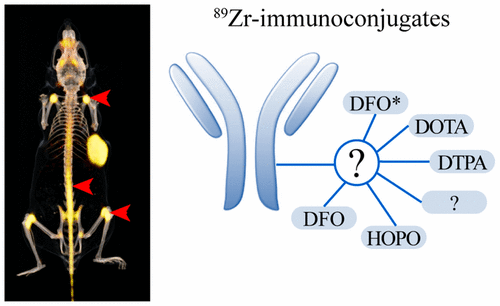当前位置:
X-MOL 学术
›
Bioconjugate Chem.
›
论文详情
Our official English website, www.x-mol.net, welcomes your feedback! (Note: you will need to create a separate account there.)
89Zr-Immuno-Positron Emission Tomography in Oncology: State-of-the-Art 89Zr Radiochemistry
Bioconjugate Chemistry ( IF 4.7 ) Pub Date : 2017-08-24 00:00:00 , DOI: 10.1021/acs.bioconjchem.7b00325 Sandra Heskamp 1 , René Raavé 1 , Otto Boerman 1 , Mark Rijpkema 1 , Victor Goncalves 2 , Franck Denat 2
Bioconjugate Chemistry ( IF 4.7 ) Pub Date : 2017-08-24 00:00:00 , DOI: 10.1021/acs.bioconjchem.7b00325 Sandra Heskamp 1 , René Raavé 1 , Otto Boerman 1 , Mark Rijpkema 1 , Victor Goncalves 2 , Franck Denat 2
Affiliation

|
Immuno-positron emission tomography (immunoPET) with 89Zr-labeled antibodies has shown great potential in cancer imaging. It can provide important information about the pharmacokinetics and tumor-targeting properties of monoclonal antibodies and may help in anticipating on toxicity. Furthermore, it allows accurate dose planning for individualized radioimmunotherapy and may aid in patient selection and early-response monitoring for targeted therapies. The most commonly used chelator for 89Zr is desferrioxamine (DFO). Preclinical studies have shown that DFO is not an ideal chelator because the 89Zr–DFO complex is partly unstable in vivo, which results in the release of 89Zr from the chelator and the subsequent accumulation of 89Zr in bone. This bone accumulation interferes with accurate interpretation and quantification of bone uptake on PET images. Therefore, there is a need for novel chelators that allow more stable complexation of 89Zr. In this Review, we will describe the most recent developments in 89Zr radiochemistry, including novel chelators and site-specific conjugation methods.
中文翻译:

肿瘤学中的89 Zr免疫正电子发射断层扫描:最新的89 Zr放射化学
具有89个Zr标记抗体的免疫正电子发射断层扫描(immunoPET)在癌症成像中显示出巨大潜力。它可以提供有关单克隆抗体的药代动力学和肿瘤靶向特性的重要信息,并有助于预测毒性。此外,它允许针对个体化放射免疫疗法进行准确的剂量规划,并可能有助于针对目标疗法的患者选择和早期反应监测。最常用的89 Zr螯合剂是去铁胺(DFO)。临床前研究表明,DFO不是理想的螯合剂,因为89 Zr–DFO复合物在体内部分不稳定,这会导致从螯合剂中释放89 Zr并随后积累骨中含89 Zr。这种骨骼积聚会干扰PET图像上骨骼摄取的准确解释和量化。因此,需要允许更稳定地络合89 Zr的新型螯合剂。在本综述中,我们将描述89 Zr放射化学的最新进展,包括新型螯合剂和特定于位点的结合方法。
更新日期:2017-08-25
中文翻译:

肿瘤学中的89 Zr免疫正电子发射断层扫描:最新的89 Zr放射化学
具有89个Zr标记抗体的免疫正电子发射断层扫描(immunoPET)在癌症成像中显示出巨大潜力。它可以提供有关单克隆抗体的药代动力学和肿瘤靶向特性的重要信息,并有助于预测毒性。此外,它允许针对个体化放射免疫疗法进行准确的剂量规划,并可能有助于针对目标疗法的患者选择和早期反应监测。最常用的89 Zr螯合剂是去铁胺(DFO)。临床前研究表明,DFO不是理想的螯合剂,因为89 Zr–DFO复合物在体内部分不稳定,这会导致从螯合剂中释放89 Zr并随后积累骨中含89 Zr。这种骨骼积聚会干扰PET图像上骨骼摄取的准确解释和量化。因此,需要允许更稳定地络合89 Zr的新型螯合剂。在本综述中,我们将描述89 Zr放射化学的最新进展,包括新型螯合剂和特定于位点的结合方法。



























 京公网安备 11010802027423号
京公网安备 11010802027423号